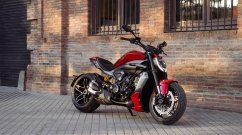Front crash prevention systems aren’t as good at preventing crashes with large trucks and motorcycles as they are crashes with cars, two new studies from the Insurance Institute for Highway Safety show.
Most front crash prevention systems include forward collision warning and automatic emergency braking (AEB). Forward collision warning alerts the driver when a rear-end crash is imminent, and AEB automatically slams on the brakes if the driver fails to respond in time.
Today’s systems reduce rear-end crash rates with medium or heavy trucks by 38 percent and rear-end crash rates with motorcycles by 41 percent, compared with a 53 percent reduction in rear-end crash rates with other passenger vehicles, an IIHS study of more than 160,000 crashes found. The same discrepancy is seen with the surrogate vehicle targets that IIHS and other organizations use to evaluate system performance, another study demonstrated.
Specifically, such systems could prevent an additional 5,500 crashes a year with medium or heavy trucks and another 500 crashes with motorcycles.
The effect on fatalities could be substantial too. A medium or heavy truck or a motorcycle is struck by a passenger vehicle in about 43 percent of fatal rear-end crashes, even though another passenger vehicle is the struck vehicle in 97 percent of rear-end crashes overall, an earlier IIHS study showed.
To determine how well today’s front crash prevention systems are addressing these crashes in the real world, Cicchino and IIHS Senior Research Scientist David Kidd compared police-reported rear-end crash rates for model year 2016-20 passenger vehicles with and without AEB and forward collision warning when the struck vehicle was another passenger vehicle, a medium or heavy truck or a motorcycle. The crash data used were police-reported crashes during 2017-21 in 18 U.S. states.
The researchers found that front crash prevention was associated with a 53 percent reduction in rear-end crashes involving another passenger vehicle, a 38 percent reduction in rear-end crashes with medium or heavy trucks and a 41 percent reduction in rear-end crashes with motorcycles.
When IIHS first began evaluating front crash prevention systems 10 years ago, few vehicles were equipped with forward collision warning or AEB, and even fewer systems qualified for an advanced or superior rating. Today practically every new passenger vehicle has the feature thanks to a voluntary manufacturer commitment brokered by IIHS and the National Highway Traffic Safety Administration. For several years running, virtually every vehicle tested has earned the Institute’s highest rating of superior in the vehicle-to-vehicle evaluation.
No longer part of the criteria for the Institute’s Top Safety Pick and Top Safety Pick+ awards, that earlier test was conducted at 12 mph and 25 mph with a target representing a passenger car.
To make sure systems are equally adept at preventing crashes with large trucks and motorcycles and to address the large portion of rear-end crashes that happen at higher speeds, IIHS is conducting a new vehicle-to-vehicle front crash prevention evaluation, with plans to publish the first updated ratings early next year.
As part of that process, Kidd partnered with researchers from Transport Canada to gauge how various front crash prevention systems react to different vehicles and surrogate targets. In total, the two organizations examined how five 2021-22 models from Acura, Subaru, Toyota, Volkswagen and Volvo reacted to 12 different nonpassenger vehicles or surrogate targets and seven different passenger vehicles or surrogate targets. Anticipating the higher speeds of the future IIHS program, the researchers conducted the tests at 31 mph, 37 mph and 44 mph.
In general, the study showed that front crash prevention systems aren’t as good at detecting other types of vehicles and surrogate targets as they are at detecting a standard passenger car target.
All five test vehicles earn the highest rating of superior in the original IIHS vehicle-to-vehicle front crash prevention evaluation. However, Kidd and his co-authors found that the systems were substantially less likely to sound an alert when a collision with certain large vehicles or with a motorcycle target was imminent than when the test vehicles were approaching the standard passenger car surrogate.
When approaching the standard passenger car target, the test vehicles sounded forward collision warning alerts in about 9 out of 10 trials. Results were statistically equivalent for most of the other target vehicles and surrogates, which included two other passenger car surrogates and a BMW X5 SUV, Ford F-250 pickup and Nissan Altima sedan among other vehicles. In contrast, the test vehicles warned of impending collisions with a school bus, fire truck, tractor trailer and dry van trailer in fewer than 8 out of 10 trials and in only about 7 out of 10 trials with the two motorcycle targets.













